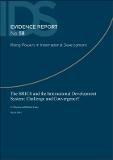| dc.description.abstract | The ‘BRICs’ acronym, in its most common usage, derives from a report to investors by Goldman Sachs’ analyst Jim O’Neill, signalling the new dynamic that four large countries; Brazil, Russia, India and China, were bringing to the global economy at the beginning of the new millennium. A conclusion advanced in the Goldman Sachs report was that the BRICs should be included in the G7 as their macroeconomic significance increased in the decade to come. From a global investment angle, the world has moved on from there to a wider set of dynamic emerging countries, including a number of fast-growing African nations, as more developing countries find their own way to catch up on growth, resisting world recessionary tendencies (O’Neill 2001 2011). The investor’s world of emerging markets has thus expanded beyond the BRICs, even as questions are raised about the sustainability of growth in the BRICs themselves, with their structural and political challenges and their vulnerability to the uncertainties of global monetary developments.
This Evidence Report focuses on a distinct phenomenon – the BRICS Summits, as an ongoing new global governance process, spanning both economic and security issues, launched as a geopolitical initiative by Russia in 2006 at the level of foreign ministers. A first Leaders’ meeting was hosted by Russia in Yekaterinburg in June 2009, bringing in Heads of State from Brazil, India and China. South Africa joined in 2010 on the invitation of China following the Sanya BRIC Summit, to make up the present BRICS Summit group.
We look at this BRICS Summit process as part of the broadening of the global governance system created following the Second World War, in which United States (US) leadership and hegemony has been a vital element, to a polycentric global governance system that is now evolving fast but with a future still undetermined (Ikenberry 2006). There is now a burgeoning literature on the BRICS, written in this vein, which is providing some of the keenest contemporary insights into the geopolitics and the geoeconomics of this still to be determined future world order (Carmody 2013; EUISS 2013; Kornegay and Bohler-Muller 2013a, 2013b; Observer Research Foundation 2013; Kornegay 2013a, 2013b, 2013c; Sidaway 2012). | en_GB |


